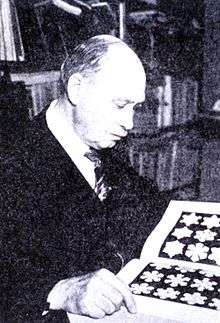William Jackson Humphreys
| William Jackson Humphreys | |
|---|---|
 | |
| Born |
February 3, 1862 Gap Mills, West Virginia |
| Died |
November 10, 1949 (aged 87) Washington, D.C. |
| Doctoral advisor | Henry Augustus Rowland |
William Jackson Humphreys (February 3, 1862 – November 10, 1949) was an American physicist and atmospheric researcher.
Biography
Humphreys was born on February 3, 1862 in Gap Mills, West Virginia to Jackson and Eliza Ann (née Eads) Humphreys.[1] He studied physics at Washington & Lee University in Virginia and later at Johns Hopkins University in Baltimore, where he earned his Ph.D. in 1897, studying under Henry Augustus Rowland.[2]
He worked in the fields of spectroscopy, atmospheric physics and meteorology. In the field of spectroscopy he found the shift of spectral lines under pressure. In atmospheric physics he found a very good model for the stratosphere in 1909. He wrote numerous books, including a textbook titled Physics of the Air, first published in 1920 and considered a standard work of the time,[2] though it was last published in 1940. He also held some teaching positions at universities. He concluded that the 1815 eruption of Mount Tambora was responsible for the subsequent cooling known as the Year Without a Summer.[3]
From 1905 to 1935 he worked as a physicist for the U.S. Weather Bureau, predecessor of the National Weather Service.[2]
He died on November 10, 1949 in Washington, D.C.
Bibliography
- Physics of the Air (1920)
- Weather proverbs and paradoxes (1923)
- Fogs and clouds, The Williams & Wilins Co. (1926)
- Rain making and Other weather vagaries (1926)
- Snow crystals (1931)
References
- ↑ Hockey, Thomas (2009). The Biographical Encyclopedia of Astronomers. Springer Publishing. ISBN 978-0-387-31022-0. Retrieved August 22, 2012.
- 1 2 3 "NOAA History - Profiles in Time/NWS Biographies". National Oceanic and Atmospheric Administration. Retrieved 2011-11-09.
- ↑ http://climate.nasa.gov/blog/183